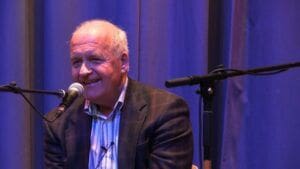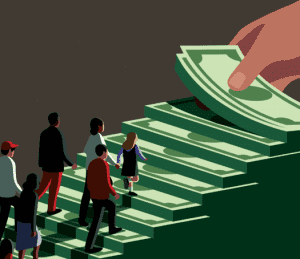America’s Social Safety Net Wasn’t Ready For The Coronavirus Crisis
Stories from the new economic reality
The coronavirus crisis is testing almost every facet of American life, including the country’s social safety net. For generations politicians have proposed (and haggled over) ways to help people during a garden-variety recession. And in the past few weeks, Congress has tried to strengthen the safeguards that already exist, passing a series of bills to get government assistance and other protections to more people, including a $2 trillion relief package with several provisions that directly affect workers and small businesses.
But most of these benefits haven’t reached Americans yet, even as more and more have been forced to rely on the preexisting safety net. Since the coronavirus crisis began to intensify, FiveThirtyEight has been reporting on which workers are most economically vulnerable, and what the government can do to help. We’d like to continue that by featuring the stories of people who are struggling to stay afloat, finding unexpected financial opportunities or simply changing the way they’re thinking about money, the economy and our country’s social safety net. To do that, we need your help — we want to hear how the coronavirus crisis is affecting you economically. Please share your experience by filling out this form.
Today, we’re bringing you three stories that illustrate a fact of American life that has become abundantly clear over the past few weeks: Our unemployment support systems are woefully underprepared for this crisis. That has caused delays in how quickly help can get to the people who need it most, and threatens to deplete states’ financial reserves. Congress just injected $260 billion into the state unemployment insurance system, and most Americans will eventually receive $1,200 relief payments. Because of the way our unemployment insurance system is set up, many Americans are still struggling to file unemployment claims, and the amount of government assistance they’ll receive will also depend on where they live. In the meantime, jobless workers are scrambling to pay their bills and discovering other cracks in the makeshift social safety net that’s been created to catch them.
We talked to three young women whose stories show how the response has varied so far.
The prospect of an economic downturn never really worried Lee Meach, 29, of Tampa, because there’s always demand for her work as a pediatric occupational therapist, even in a sour economy. She thought it was her husband, Josh Frank, an urban designer who co-owns a landscape architecture and urban design firm, who had the unstable job. But soon after Florida public schools began to close and their county rolled out social-distancing ordinances, Meach’s boss announced that the clinic where she works would be closing its doors for the foreseeable future. She and all her co-workers were laid off indefinitely.
Meach was stunned — and unprepared. “I always thought my job was recession-proof,” she said. “And then I went from being extraordinarily busy to unemployed in less than a week.” She and Frank had bought a house three months earlier, so she was immediately concerned about how they would pay the mortgage — much less their student debt. That concern morphed into panic when she began to investigate Florida’s unemployment insurance system and found that the state would pay only up to $275 per week in benefits, just a fraction of what she had been making at her job.
The coronavirus crisis is putting a lot of pressure on the unemployment system and exposing the dramatic variations in states’ relative generosity or stinginess with benefits. The federal government is attempting to standardize how much money people like Meach will receive by tacking an additional $600 per week onto every unemployed person’s benefits for the next four months. But because of steps that some states like Florida have taken to restrict their unemployment insurance program, government aid to jobless workers will still be distributed unevenly.
In the wake of the Great Recession, Florida was among the states that created a complex patchwork of requirements for jobless workers. The state also capped benefits at 12 weeks — far below the national standard of 26 weeks. As a result, the share of unemployed workers receiving benefits in Florida and several other states with similar restrictions fell precipitously. In 2019, only 11.3 percent of the out-of-work population in Florida was receiving benefits, down from 30 percent in 2007. That recipiency rate — the share of unemployed people who actually receive benefits — is far below the 50 percent experts told us is typical during normal times, although that share usually rises during recessions.

Many of the most burdensome restrictions have now been lifted in response to the coronavirus crisis, which means it should be easier for workers to receive benefits. And in fairness to Florida, states that were distributing benefits to a bigger share of unemployed workers were also unprepared for the recent influx of claims. But even with the additional $600 per week, jobless Floridians will still be getting far smaller payouts than workers in other states, where the maximum payments can be two or three times higher. And that’s assuming the money makes it into their wallets anytime soon. Hours after Meach was laid off, she went online to submit her application to get unemployment benefits, only to be confronted by an antiquated and labyrinthine system online. “You can’t refresh or you’ll lose all your progress,” she said. “It took me about three hours to figure out where to upload my resume.”
In the meantime, she and Frank have scrambled to find other sources of income. He picked up some shifts taking calls and doing administrative work at his father’s small business, while Meach grabbed a few extra hours as a remote lecturer. They also took advantage of their bank’s offer to defer their mortgage payments. Meach finally got her unemployment application submitted by logging onto the website in the early morning, more than a week after she lost her job. By some measures, she was lucky — Florida’s online system has been functioning so poorly that the state director of unemployment announced last week that his office will start issuing paper applications for jobless workers to mail in.
But Meach doesn’t feel especially victorious, because she still has no idea when she’ll actually get the money. “We’re doing a lot to try to make things work financially,” she said. “But the unemployment benefits are a big piece of the puzzle for us, so it’s very stressful to wonder when and if that’s going to come through.”
The bad news started for Chloe Carter-Daves, 21, when she lost her part-time job at a restaurant in New York City in mid-March. It continued when — after weeks of daily attempts — she still wasn’t able to submit a claim for unemployment insurance. And it culminated in the discovery that because she’s a student, she won’t be receiving a $1,200 relief check from the federal government like most Americans, even though she’s been supporting herself without help from her parents over the past few years.
The vast majority of Americans will receive a payment from the federal government over the coming weeks. But college students (and some high school students) fall into a kind of no man’s land: They often don’t file their own tax returns, even if they’re basically self-sufficient, which means they won’t qualify for the relief checks. And their families won’t receive a child payment for them either since they’re over the age of 16.
For some students who are living at home, that might not be such a burden. But Carter-Daves, a senior at Hunter College, stayed in her off-campus apartment, which means she’s still paying for her own rent and groceries. “I’ll be real — even when I was working, I was living paycheck to paycheck,” she said. “That $1,200 would have given me another month of breathing room.”
Cutting most college students out of the relief payments could turn out to be a particularly big oversight because young workers are at an especially high risk of losing their jobs right now. As Ryan Best and I wrote on March 18, workers under age 25 are disproportionately more likely to lack both paid sick leave and the ability to work from home. Younger workers are also especially likely to work in the service and retail sales industries — which have both been among the hardest-hit sectors of the economy.
If Carter-Daves can get her unemployment insurance claim through, she says she should be OK financially, at least for a while. Her home state of New York has fairly generous benefits for jobless workers. But it was unprepared for the recent tsunami of unemployment claims in a different way. A Department of Labor report from February named New York among six states whose unemployment systems don’t have enough money in their reserves to handle a normal recession. And, so far, the federal government hasn’t taken steps to bail out cash-strapped state and local governments, which means that big states like New York and California are at risk of quickly burning through their unemployment insurance funds.
But more than two weeks after Carter-Daves lost her job, the website seemed to have become even less functional. “For a while, the issue was that I would start my application, get halfway through, and then the website would crash,” she said. “Now when I log in, there’s no more option to file a claim.” She’s far from the only New Yorker for whom wrestling with the unemployment insurance website has become a full-time job — last week, Gov. Andrew Cuomo apologized for the site’s frequent crashes and said the state was working on fixing the problems.
In the meantime, Carter-Daves applied for an emergency assistance grant from her school and got enough money to cover her April rent. But she’s already worried about future bills — particularly since, as a college senior, she’s facing the dismal prospect of graduating into a frozen economy. “I was planning on leaving the service industry once I graduated,” she said. “Now I think I’m going to be grateful if I have any income at all.”
Before the coronavirus crisis hit, Rebekah Guerra, 26, was already living on a shoestring budget in Los Angeles County. Faced with a mountain of student and medical debt, she moved back in with her parents last year while she tried to jump-start her business as a freelance marketing professional. But over the course of a few weeks in March, any semblance of financial stability evaporated. “I work with a lot of smaller businesses, and they’ve either closed their doors entirely or marketing is not their focus,” she said. “I can’t really blame them — what is there to market if they have no business? But it means my work has completely gone away too.”
Up until recently, freelancers and independent contractors like Guerra were left out of the social safety net for jobless workers, since they don’t usually qualify for unemployment insurance. That changed with the new bill passed by Congress, which created a new emergency unemployment program to cover them. But it could be complicated for states that are already swamped with claims to set up a new infrastructure to funnel funds to freelancers, whose incomes will be harder to verify. There are also questions about which freelancers will qualify, since according to new guidance from the federal government, people who can telework with pay are ineligible — and it’s not clear what that will mean for people like Guerra, who are theoretically able to work from home but have lost all their business. Experts estimate that it could be weeks before the payments are actually distributed.
And for Guerra, any delay could bring her closer to financial catastrophe. She has a chronic health condition that requires her to spend hundreds of dollars a month on medication. And she struggled to pay for her health insurance premium at the beginning of the month. “I’m reassessing my budget — giving up subscriptions, thinking about things like whether I can go to a lower level of coverage on my car insurance,” she said.
All of this means that, to Guerra, the prospect of receiving government benefits — through unemployment insurance or a stimulus check — feels tantalizing but remote. “The help is great, but I don’t know if it will get to me in time,” she said. “It’s not like I had a financial buffer before this. I understand the system is overloaded and I want to be patient, but my bills are coming due now.”
Amelia Thomson-DeVeaux is a senior writer for FiveThirtyEight. @ameliatd





















